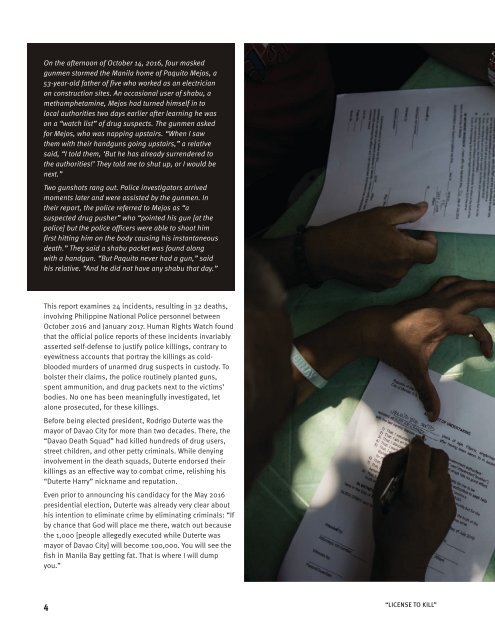“License to Kill”
nDPE309A46S
nDPE309A46S
Create successful ePaper yourself
Turn your PDF publications into a flip-book with our unique Google optimized e-Paper software.
On the afternoon of Oc<strong>to</strong>ber 14, 2016, four masked<br />
gunmen s<strong>to</strong>rmed the Manila home of Paqui<strong>to</strong> Mejos, a<br />
53-year-old father of five who worked as an electrician<br />
on construction sites. An occasional user of shabu, a<br />
methamphetamine, Mejos had turned himself in <strong>to</strong><br />
local authorities two days earlier after learning he was<br />
on a “watch list” of drug suspects. The gunmen asked<br />
for Mejos, who was napping upstairs. “When I saw<br />
them with their handguns going upstairs,” a relative<br />
said, “I <strong>to</strong>ld them, ‘But he has already surrendered <strong>to</strong><br />
the authorities!’ They <strong>to</strong>ld me <strong>to</strong> shut up, or I would be<br />
next.”<br />
Two gunshots rang out. Police investiga<strong>to</strong>rs arrived<br />
moments later and were assisted by the gunmen. In<br />
their report, the police referred <strong>to</strong> Mejos as “a<br />
suspected drug pusher” who “pointed his gun [at the<br />
police] but the police officers were able <strong>to</strong> shoot him<br />
first hitting him on the body causing his instantaneous<br />
death.” They said a shabu packet was found along<br />
with a handgun. “But Paqui<strong>to</strong> never had a gun,” said<br />
his relative. “And he did not have any shabu that day.”<br />
This report examines 24 incidents, resulting in 32 deaths,<br />
involving Philippine National Police personnel between<br />
Oc<strong>to</strong>ber 2016 and January 2017. Human Rights Watch found<br />
that the official police reports of these incidents invariably<br />
asserted self-defense <strong>to</strong> justify police killings, contrary <strong>to</strong><br />
eyewitness accounts that portray the killings as coldblooded<br />
murders of unarmed drug suspects in cus<strong>to</strong>dy. To<br />
bolster their claims, the police routinely planted guns,<br />
spent ammunition, and drug packets next <strong>to</strong> the victims’<br />
bodies. No one has been meaningfully investigated, let<br />
alone prosecuted, for these killings.<br />
Before being elected president, Rodrigo Duterte was the<br />
mayor of Davao City for more than two decades. There, the<br />
“Davao Death Squad” had killed hundreds of drug users,<br />
street children, and other petty criminals. While denying<br />
involvement in the death squads, Duterte endorsed their<br />
killings as an effective way <strong>to</strong> combat crime, relishing his<br />
“Duterte Harry” nickname and reputation.<br />
Even prior <strong>to</strong> announcing his candidacy for the May 2016<br />
presidential election, Duterte was already very clear about<br />
his intention <strong>to</strong> eliminate crime by eliminating criminals: “If<br />
by chance that God will place me there, watch out because<br />
the 1,000 [people allegedly executed while Duterte was<br />
mayor of Davao City] will become 100,000. You will see the<br />
fish in Manila Bay getting fat. That is where I will dump<br />
you.”<br />
4 “LICENSE TO KILL”


